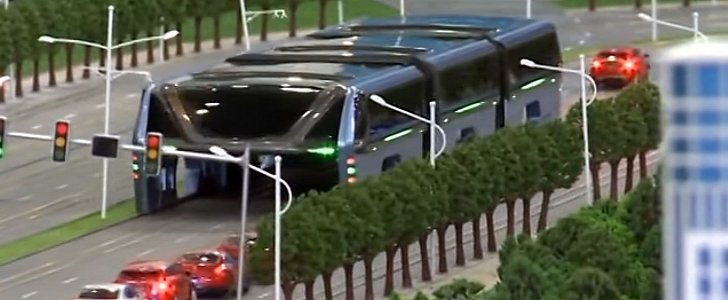If you happened to be born back in 1969 and lived in the USA, you may remember something called the Bos-Wash Landliner. It looked like the sort of thing people back then imagined would roam the streets in the year 2000, and came with the promise of a top speed of 200 mph.
Fast forward to 2010 and, on the opposite side of the Earth, a Chinese engineer by the name of Song Youzhou came up with a similar design that, he declared, would help alleviate (if not solve altogether) the growing issue of heavy traffic that the larger Chinese cities were beginning to face.
His design differed from the original, but the idea was the same: a vehicle traveling on stilts that would allow other, smaller vehicles to pass underneath is as it makes its way forward. If the US concept proposed inter-city commuting, the Chinese version is thought to function as an urban transport solution that can take the place of buses, trams, and even subway.
The advantages are pretty clear: the "straddling bus" has an almost zero ground footprint, so it doesn't put any burden on traffic. It can carry up to 1,400 passengers, which is the equivalent of around 40 buses. That means less pollution (it would cut fuel consumption by 800 tons a year and CO2 emissions by almost 2,500 tons, Song told Chinese news agency, Xinhua), but also fewer vehicles on the streets. And just like the subway, it would be impervious to congestion as it would glide above it, but at a much lower cost than the underground trains.
Even if everybody keeps calling it a "bus," it is actually a train that runs on two tracks on each side of the street while getting its power from the nearby posts. In fact, even if building its tracks would be considerably cheaper than excavating for a subway, it would still require some adjustments for the surface infrastructure.
Let's not hide behind words: it is basically a moving bridge that follows the tracks, has a closed top, and lots of seats. It is about 60 meters long (197 feet), it's made up of four interconnected segments, has a clearance of 2.1 meters (almost 7 feet), and an overall height of 4.5 meters (14.7 feet). A scale model of the bus was presented by the Beijing-based company Transit Explore Bus at the 19th International High-Tech Expo where it spun around an equally scaled model city complete with moving cars.
It would appear that, after the first failed attempt in 2010, the project is going to receive a new chance. Transit Explore Bus is building a full-size model which it plans to test this August in the city of Changzhou. If it proves to be successful, a more widespread implementation could follow. And while this might help curb the traffic situation, it won't do that much to help with the air pollution, at least not as long as China continues to rely so heavily on coal for obtaining electricity. However, things have to start from somewhere, and the straddling bus seems like a very good place to do that.
His design differed from the original, but the idea was the same: a vehicle traveling on stilts that would allow other, smaller vehicles to pass underneath is as it makes its way forward. If the US concept proposed inter-city commuting, the Chinese version is thought to function as an urban transport solution that can take the place of buses, trams, and even subway.
The advantages are pretty clear: the "straddling bus" has an almost zero ground footprint, so it doesn't put any burden on traffic. It can carry up to 1,400 passengers, which is the equivalent of around 40 buses. That means less pollution (it would cut fuel consumption by 800 tons a year and CO2 emissions by almost 2,500 tons, Song told Chinese news agency, Xinhua), but also fewer vehicles on the streets. And just like the subway, it would be impervious to congestion as it would glide above it, but at a much lower cost than the underground trains.
Even if everybody keeps calling it a "bus," it is actually a train that runs on two tracks on each side of the street while getting its power from the nearby posts. In fact, even if building its tracks would be considerably cheaper than excavating for a subway, it would still require some adjustments for the surface infrastructure.
Let's not hide behind words: it is basically a moving bridge that follows the tracks, has a closed top, and lots of seats. It is about 60 meters long (197 feet), it's made up of four interconnected segments, has a clearance of 2.1 meters (almost 7 feet), and an overall height of 4.5 meters (14.7 feet). A scale model of the bus was presented by the Beijing-based company Transit Explore Bus at the 19th International High-Tech Expo where it spun around an equally scaled model city complete with moving cars.
It would appear that, after the first failed attempt in 2010, the project is going to receive a new chance. Transit Explore Bus is building a full-size model which it plans to test this August in the city of Changzhou. If it proves to be successful, a more widespread implementation could follow. And while this might help curb the traffic situation, it won't do that much to help with the air pollution, at least not as long as China continues to rely so heavily on coal for obtaining electricity. However, things have to start from somewhere, and the straddling bus seems like a very good place to do that.


